Gorilla Trekking in Rwanda
Volcanoes National Park
GORILLA TREKKING - INFORMATION AND GUIDELINES
General Info
Mountain Gorillas live at high altitude in Volcanoes National Park. There are currently ten habituated gorilla families. A maximum of eight visitors per day can visit each family and viewing time is limited to maximum one hour. Gorilla trekking involves walking long distances through thick vegetation, up steep, wet and muddy terrain. This may cause difficulties for some visitors. We recommend you pace yourself; walk slowly and drink plenty of water. No one should feel deterred from making this trip. Children under 15 yrs of age are not allowed on gorilla treks.
For many years these groups have undergone an extremely delicate process that has gradually made them accustomed to the presence of humans and has allowed a few privileged visitors to interact with them briefly in the wild. However, the gorillas are by no means tame. They are completely wild animals, which even now tolerate human presence for an hour a day at most. Experienced guides will accompany you on your tracking, many of who have been involved in the habituation process themselves. These guides will brief you in detail on your arrival on the various aspects of 'gorilla etiquette', but the information contained here will help ensure you are well prepared and ready to enjoy this unique opportunity to the fullest.
Visitors may track for as many days as they like, provided they purchase the required gorilla permit for each day. The permits are in extremely short supply and are often booked up as early as 18 months in advance. Only persons over the age of 15 are allowed to track the gorillas.
Permit cost: The cost for one permit (as of 01-June 2012) is $750.
Gorilla tracking is a year-round activity, with no season as such. The forest is moist and it rains quite often in Volcanoes National Park, even in the dry season. Trekking commences every morning from the park headquarters at 8:30 AM. There is a daily maximum of eight visitors to each gorilla group and each group is accompanied by a guide and by porters who will carry your shoulder pack for you. The gorillas may cover large distances overnight and they are never constantly in one area. The gorilla location trackers will use their knowledge of the gorillas' habits and information from the previous day to locate the group's whereabouts and their job is to locate the gorilla group before you head on your trek so that your guide is able to take you directly to them.
Trekking conditions differ greatly according to the location of the gorillas, so the exact level of difficulty for a specific trek is impossible to define in advance. However, at the time of assignment to a gorilla group at the Park HQ, you will be asked if you would like an "easy" trek or a "more challenging" trek, so if you are not sure, make sure to get onto a shorter trek.
On an excursion, it is entirely possible that you will find the gorillas quite quickly and be back at your hotel for lunch. It is also entirely possible that you will have to hike three or four hours (or sometimes even longer) each way and will make it back to your hotel just before dark (you may therefore wish to bring some snack bars with you on the trek just in case). Because it is impossible to predict the length and difficulty of any single tracking excursion, this program should not be attempted by anyone who is not in fairly good physical condition.
Because of the climbing and bending required as you make your way through the thick foliage, gorilla tracking should not be attempted by anyone who has any kind of heart or back problem. Only those who are confident that they are capable of walking at high altitudes over slippery, muddy terrain should attempt gorilla trekking. Trekking may also involve scrambling through, over, and under dense undergrowth with nettles, barbed vines, and bamboo thickets. Correct footwear and clothing are essential (see our clothing recommendations in the next section below). It is recommended that you build up the strength and endurance of your leg muscles by walking, stair climbing, bicycling, doing knee bends, and similar exercises before you leave home. This should always be done under the supervision of your doctor
Remember, the slopes are steep (often steeper than a flight of stairs) and covered in dense vegetation. Furthermore, the high altitudes of 5,200 feet and more means you will have to work a bit harder than at home if you are living at lower altitudes. This all said, the group will make frequent rest stops along the way to make sure everyone has ample time to rest and catch their breath along the way. You will also have the use of walking sticks which are provided. Once the gorillas are located, your group will be allowed a maximum of one hour with them. After this, you will return to the park headquarters and your camp.
Weather / Clothing and Supplies
The climate in the Virungas is typically damp, with daytime temperatures averaging 50°F (10°C).
Dry Season: June to September and January and February are the driest months and best for gorilla trekking, but be prepared for afternoon thunderstorms at any time.
Rainy Season: The long rains are from mid-march to mid-May, when many roads become impassible. It also usually rains in October and November.
Recommended clothes and supplies for trekking:
• A small, lightweight, frameless, waterproof back/day pack.
• Light, waterproof hiking boots or shoes with treaded soles.
• Thick socks and gaiters to wear over your pants and shoes.
• Leather or heavy canvas (gardening-style) gloves for moving through the vegetation and especially avoiding any contact with stinging nettles.
• Waterproof rain pants and top with hood.
• Short sleeved shirt or T-shirt.
• Long pants worn under the rain pants should be the light-weight trekking variety. Many just wear their lightweight rain pants instead of trousers.
• A waterproof, squash-able hat.
• Bottles of water (bring more than you think you'll need),
• Energy bars or other high-energy snacks to keep you fueled.
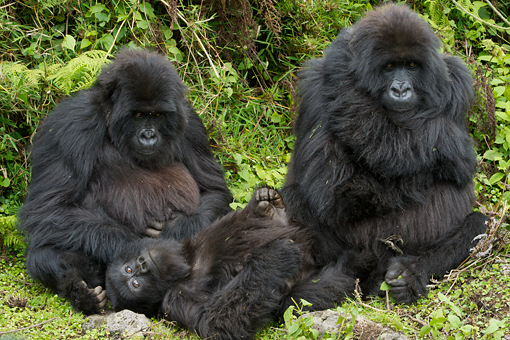 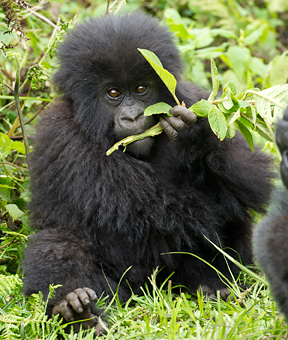
Gorillas from the Ugyenda group - Copyright © James Weis / Eyes on Africa
Illnesses and colds
Please do not go on a gorilla trek if you know you have an illness that is contagious. You may pass the disease on to the gorillas with disastrous results. If you suspect that you have such an illness, report it to your local guide or to the guide at the park headquarters. There is a good chance that you will be refunded the cost of your gorilla permit. If you do not disclose your illness and the guide detects it, you will be barred from trekking and your permit price will definitely not be refunded. Illnesses in this case include common colds, coughs, diarrhea and influenza.
Details of the Trek
Each traveler is assigned his or her own porter for the duration of a tracking excursion (you may ask for two porters if you would like and there never seems to be a shortage ready and willing porters... remember that they can all use the income and it is very inexpensive... see the section on Tipping below).
As you set off from the starting point, your guide will lead you to the trek to find the early morning trackers (who have set off at first light separately from you and your guide) and likely have already located the gorilla family. Your group's lead tracker will have his "own" gorilla family, which he visits each day and whose home range and travel routes are familiar to him. All trackers are experienced in looking for signs of the gorillas, such as footprints, dung, chewed bamboo and celery stalks, and abandoned nests from the previous evening. Gorillas soil their nests and then abandon them to build new ones each night, and trackers are able to tell the age of the nests as well as which group made them. On days of heavy rain, it is more difficult to distinguish signs of the gorillas and the age of nests.
Gorillas do not live in the most easily accessible terrain and some of it is virtually impenetrable. They prefer secondary growth vegetation with plenty of food plants near the ground and think nothing of climbing extremely steep slopes to get it. Unfortunately, this means that tracking gorillas can be difficult for humans. If the gorillas you are tracking have wandered deep into the forest, it is entirely possible that the trek to find them will take three or four hours (or sometimes even longer) in each direction. Additionally, you may have to overcome mud, stinging nettles, and some areas of elevated vines where your feet may not touch the ground. The trek can be difficult in both directions (out to the gorillas and back to the starting point).
Your guide will allow time to stop and rest along the trail; however, they tend to hike at a steady, somewhat upbeat pace throughout the excursion, for they must be mindful of the time to ensure that you will be able to reach the gorillas, spend a full hour with them, and make it back down the trail before dark. If you occasionally lag behind the group to take photos or are having difficulty negotiating a steep or slippery portion of the trail, your porter will stay with you to assist; but the group will most likely continue forward.
You will probably smell the gorillas before you actually see them. When you reach the forward trackers, you will all gather whatever cameras you want and leave your packs behind with the trackers. When everyone is ready, your guide will move forward, making soft smacking and groaning sounds with his mouth, to assure the group that friends are approaching. Although gorillas make very few vocalizations, this sound of reassurance is one that family members often use with each other.
If your trek to find the gorillas has not been unusually long, you are likely to visit them during their long midday rest and play period. At this time of day, the dominant male (usually a silverback) generally lounges on the ground or against a tree while youngsters roll in the vegetation and climb on trees, vines, and each other. Females nurse and play with their infants. Occasionally, a curious youngster may approach you or someone in your group. Though it is tempting to touch, this is STRICTLY forbidden.
Your trekking group will be instructed to stay together and crouch down while observing the gorillas so that the dominant male can see you at all times and the family does not feel threatened, surrounded, or overwhelmed. Never stare directly into the eyes of a gorilla, for a fixed stare is as aggressive to them as it is to most humans. Although you may find a gorilla looking directly at you, you should maintain a subservient stance and look at it sideways or from a lower height. Sometimes, as a release of tension or as a display to the rest of the group, a male gorilla may charge and beat his chest, tearing up vegetation and hurling his tremendous frame directly at your tracking group. Despite the temptation to run, you must stand your ground, maintain a subordinate, crouching position, and do your best not to flinch -- for the gorilla will stop before actually reaching you and calmly return to his previous location, glancing back at you with smug satisfaction. Such displays may turn savage when used between males of different gorilla families but are simply a bluff when used with human observers on tracking excursions to habituated gorilla groups.
Your trekking group will spend up to one hour with the gorillas on each excursion. This time limit is carefully observed and protects the gorillas from undue stress. If your group were to stay longer than this, the gorillas would probably end the visit themselves -- by simply leaving. Although they are getting used to being visited regularly and are curious about their human visitors, they are accustomed to one-hour visits and their intensely shy and private nature will reassert itself in the end.
In the event a gorilla trekking participant is unable to complete a tracking excursion to the gorillas, he or she will either be allowed to immediately return to the base of the trail with a porter OR the participant will be asked to remain in place with a porter while the group continues its track of the gorillas, rejoining the rest of the group on its way back to the base of the trail.
Please keep in mind that gorillas are shy, wild animals. At the start of the trekking day, there is no way of telling exactly where the habituated gorilla families are (even though trackers are very skilled at looking for signs of gorillas and their paths of travel). Also, because gorillas are wandering animals that favor areas of dense vegetation, consistent, clear viewing at close range cannot be guaranteed.
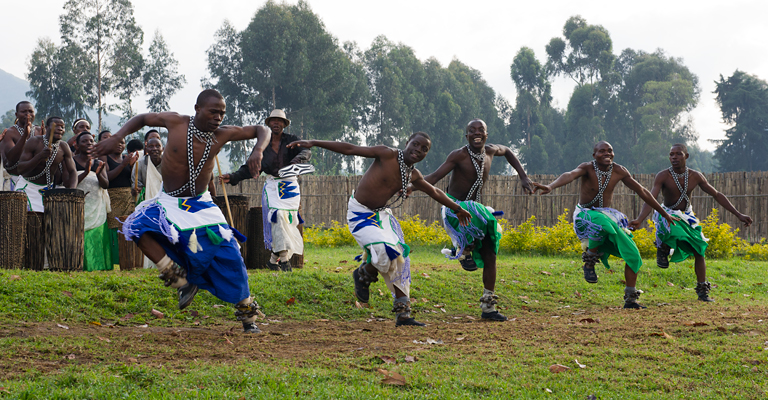
Rwandan dance troupe at Volcanoes NP HQ, Kinigi - Copyright © James Weis / Eyes on Africa
Gorilla Trekking Families
There are currently 10 gorilla families that are visited each day in Volcanoes National Park, Rwanda (updated: February 2012).
Note: This information for the gorilla families is fairly stable; however, the group specifics do fluctuate over time due to movements within and amongst the families, as well as changes resulting from new births, male juveniles leaving to be solitary, female juveniles moving to new gorilla groups, etc.
| Family Name |
Individual Members |
Dominant Silverback |
Location |
Characteristics |
| Agasha |
25 |
Agasha |
Sabyinyo Volcano |
Agasha means 'the news' |
| Amahoro |
17 |
Ubumwe |
Bisoke Volcano |
Led by the calm and easy-going Ubumwe. A fairly steep climb to reach them. Amahoro means 'peaceful'. |
| Bwenge |
10 |
Bwenge |
Between Bisoke / Sabyinyo Volcanoes |
New group. Bwenge means 'brightness'. |
| Hirwa |
12 |
Munyinya |
Between Sabyinyo / Gahinga Volcanoes |
Formed recently from different groups -- mainly Agasha and Sabyinyo. Hirwa means 'Lucky one'. |
| Kwitonda |
18 |
Kwitonda |
Between Sabyinyo / Gahinga Volcanoes |
Kwitonda means 'humble one'. This group has 3 Silverbacks. Migrated from DRC. Tends to range widely, making it a moderately difficult hike. |
| Ntambara |
12 |
Ntambara |
Between Bisoke & Sabyinyo Volcanoes |
New group. Ntambara means 'war'. Currently has 2 Silverbacks, 5 Females, 1 Blackback and 4 Babies. |
| Sabyinyo |
12 |
Guhonda |
Sabyinyo Volcano |
Easiest group to track, often closest to the park's edge. Named after the rugged Sabyinyo volcano. Sabyinyo means 'old man's teeth'. Guhonda is the biggest Silverback of all the groups - he is massive and powerful at 220 kgs. |
| Susa (2 sub-groups) |
43
(28 + 15) |
Kurira |
Karisimbi Volcano |
Hardest group to track, as they tend to range high into the mountains. The largest Gorilla Family in the world, it has since subdivided into two groups. The one originally studied by Dr. Dian Fossey. Named after the Susa river. Well known for their rare twins - Byishimo & Impano. Has four Silverbacks. Kurira means 'crying'. |
| Ugyenda |
11 |
Ugyenda |
Between Bisoke / Sabyinyo Volcanoes |
New group. Ugyenda means 'departure'. |
| Umubano |
11 |
Charles |
Bisoke Volcano |
Originally part of Amahoro group. They broke away when Charles challenged Ubumwe, the dominant Silverback. Umubano means 'Live Together'. |
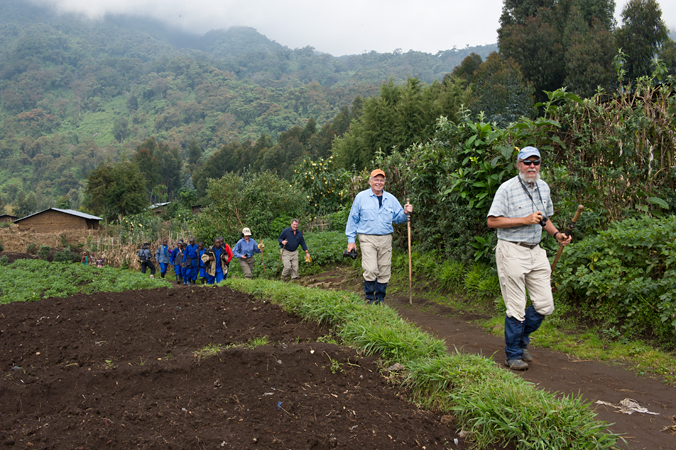
Trekking through farm fields en route to Bisoke volcano and Amahoro Group - Copyright © James Weis / Eyes on Africa
Regulations and Rules of Conduct
It is important that all gorilla trekking participants familiarize themselves with the following regulations and rules of conduct:
• You MUST, at all times, follow the instructions of your guide. He is in contact with the gorillas every day and understands them well. Always remain in a quiet, compact group behind the guide, who will attempt to position you in such a way that the dominant male of the group can see you at all times.
• If the dominant male gorilla (usually a silverback) approaches very closely or if he charges, it is very important that you do not move backwards. Remain exactly where you are, look downward, and adopt a submissive, crouched posture. NEVER make any sudden moves or loud noises in the presence of the gorillas.
• If a young gorilla approaches, NEVER (under ANY circumstances) make any move to touch it. Your guide, in certain instances, may take steps to discourage a youngster from touching you, as this could create a threatening situation with the dominant male
• If a gorilla stares at you, look away or down.
• NEVER use a flash when photographing the gorillas.
• Only visitors in good health AT THE TIME OF THE EXCURSION will be permitted to track gorillas, as gorillas are susceptible to common colds and other respiratory diseases transmitted by humans. All visitors must be physically fit and capable of enduring a walk of several hours in difficult terrain (as described above).
• Each gorilla family may be visited only once each day, during the morning hours. At this time, all gorilla visits are limited to a maximum of eight persons per gorilla family for a maximum length of one hour. Due to the already-limited number of persons allowed to visit the gorillas each day, it is not possible to do gorilla tracking on a private basis.
• Smoking, eating, and/or drinking is not permitted within 200 meters of a gorilla family.
• It is prohibited to destroy any vegetation unnecessarily or to make open fires in the national parks and reserves. The flora and fauna of national parks and reserves are strictly protected. All visitors must carry their own litter with them out of the park or reserve, leaving NOTHING behind.
• Children under the age of fifteen (15) cannot be accepted on gorilla tracking excursions. As mentioned previously, travelers should be in good physical condition and be physically and mentally prepared to walk long distances over rough terrain if that is where the search for gorillas takes them.
Note: Eyes on Africa does not control the administration nor play any part in the operation of Rwanda's national parks or reserves. These areas are the total responsibility of local authorities. If the local staff observes situations that merit improvement, they will request that local authorities make changes; but these authorities are under no obligation to do so. While our local ground handlers have cultivated an excellent relationship with local authorities and they are always eager to help us look after our clients, it is they who operate the actual gorilla tracking excursions not Eyes on Africa nor our local counterparts. It should also be noted that Eyes on Africa and our ground handler do not employ any of the local guides, gorilla trackers or porters and therefore, we cannot accept responsibility for the manner in which they operate. Travelers should keep in mind that the trackers are local, native-born people who have spent a lot of time in the forest with the gorilla families and that they probably have very good reasons to do things a certain way.
Tipping your Guides, Trackers and Porters
The following are guidelines and you may tip more or less at your discretion:
• Porter US $10 per trek.
• Gorilla Trek Guide US $20 per trek.
• Gorilla Trek Assistant Guide US $10 per trek.
• Gorilla Trackers US $5 per tracker per trek (usually 3 or 4 trackers are used to find the gorillas).
• Gorilla Security trekker US $5 per trek.
Please bear in mind that Porters do not earn any salary, and if you do choose to take a porter (highly recommended) or two, he or she will depend on your tip for remuneration. Guides (1-2 per group), Trackers (2-4 per group) and Security personnel (1-2 per group) do earn salaries.
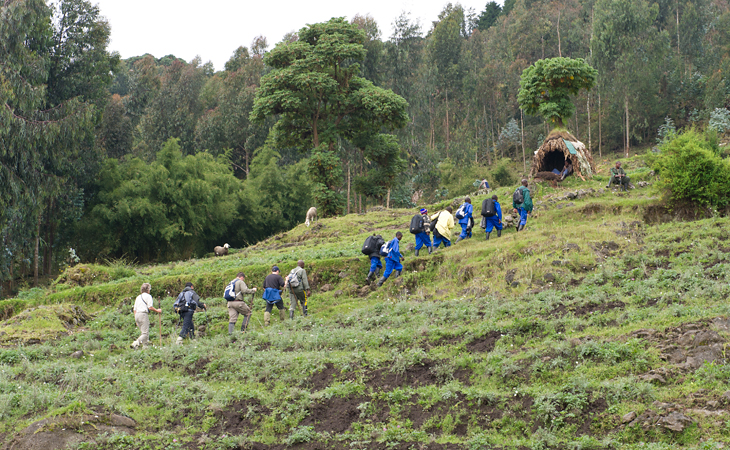
Trekking through farm fields en route to Bisoke volcano and Ugyenda Group - Copyright © James Weis / Eyes on Africa
 Top
Top  Return to Map of
Volcanoes National Park
Return to Map of
Volcanoes National Park
 For
History and General information about Rwanda, click Rwanda Info For
History and General information about Rwanda, click Rwanda Info
 For information about the National Parks of Rwanda, click Rwanda Parks
For information about the National Parks of Rwanda, click Rwanda Parks
|